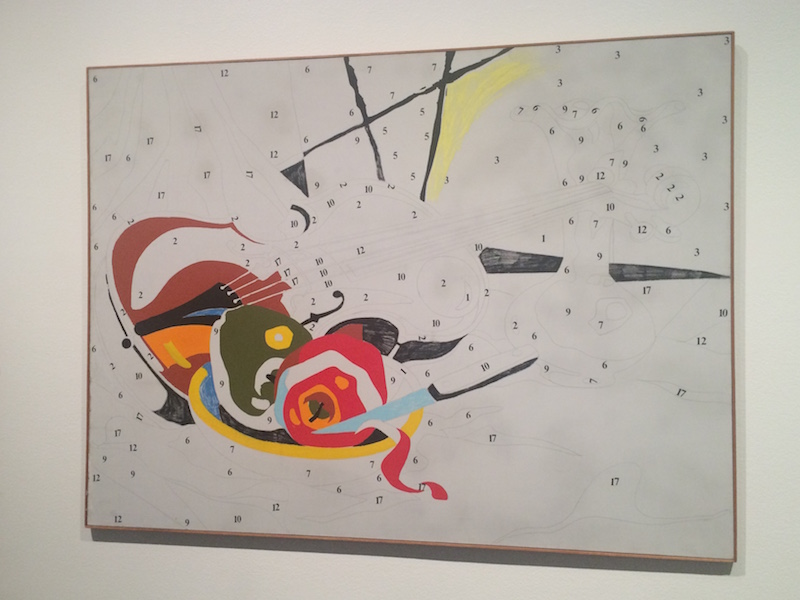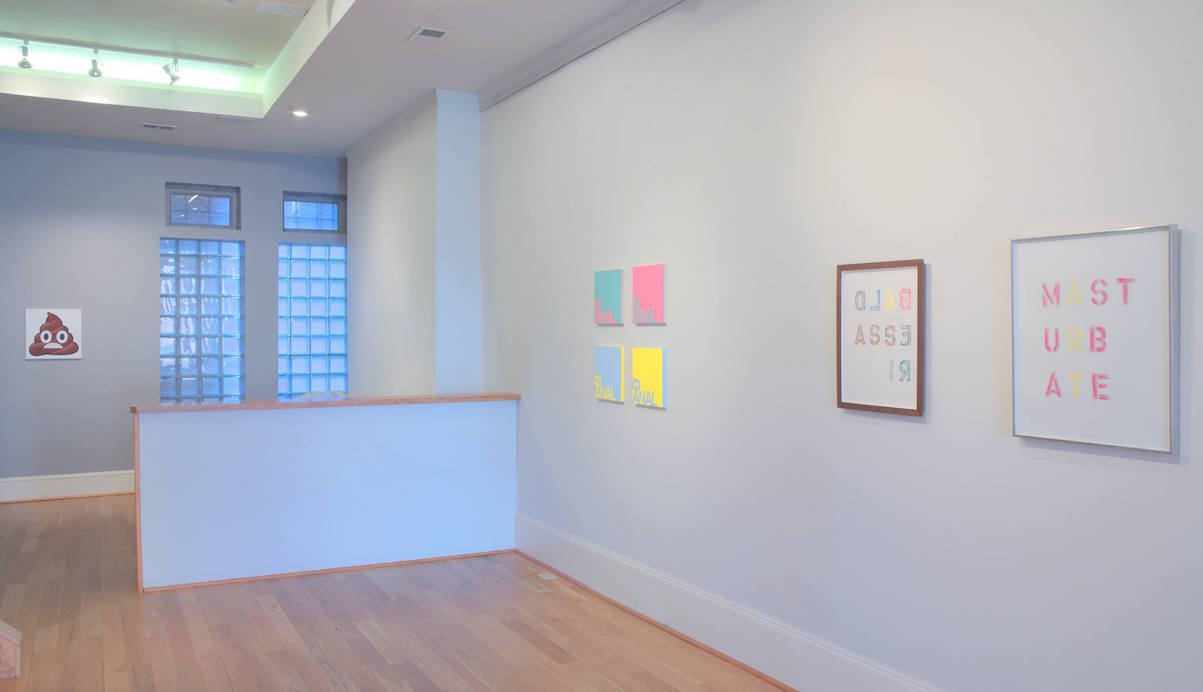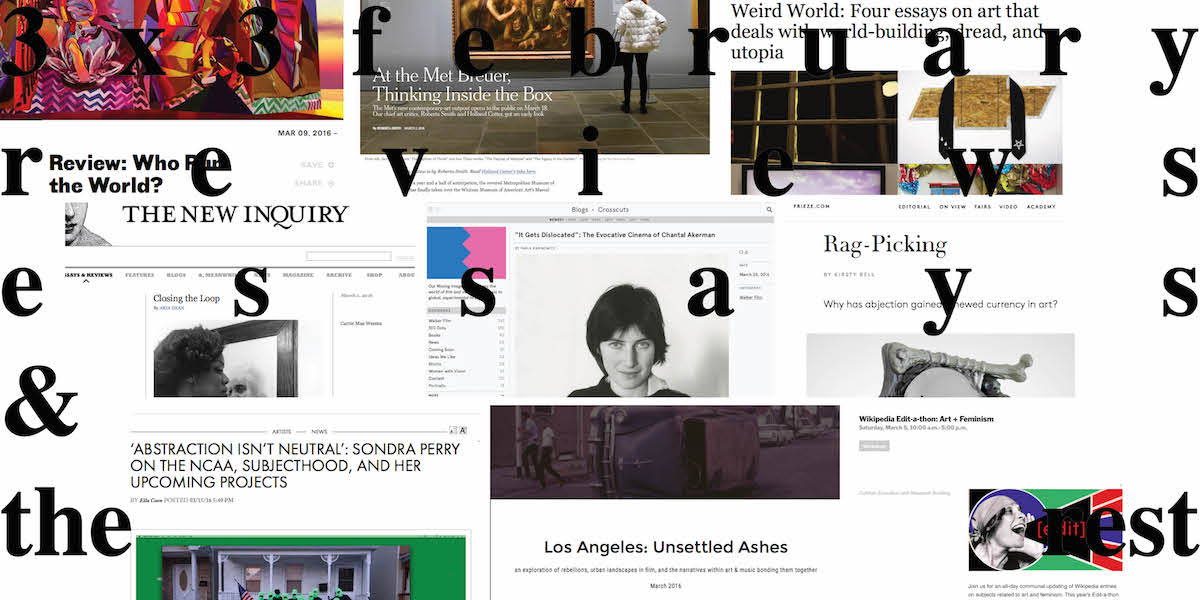Writer Joseph Shaikewitz rounds up his favorite pieces of art writing and online content from March 2016
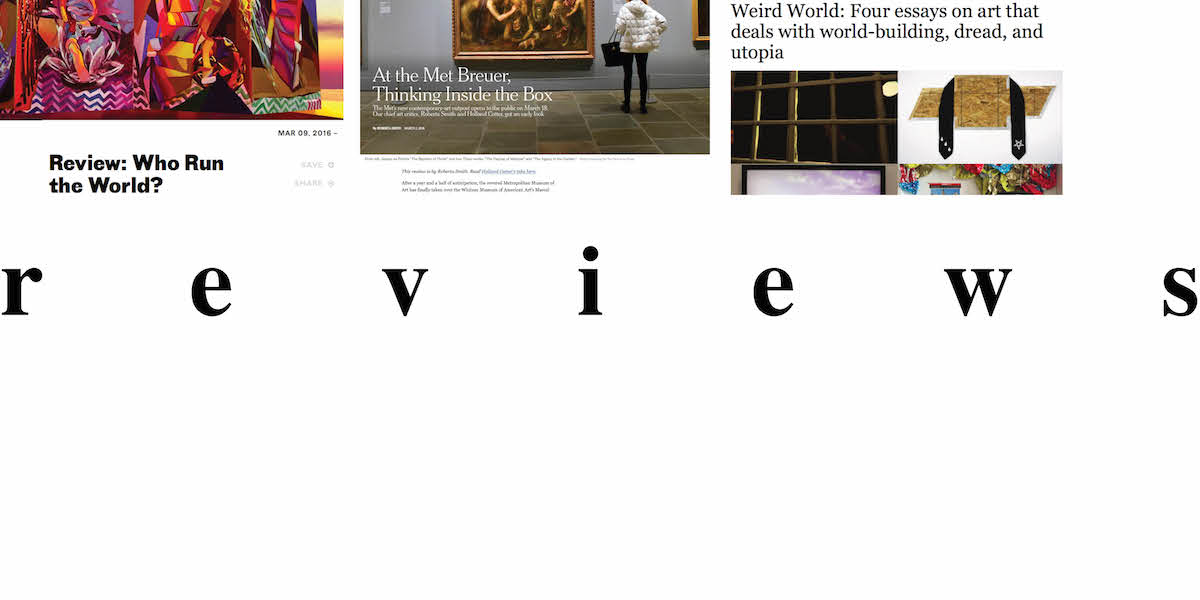
REVIEWS
Wendy Vogel, “Who Run the World?: On “Intersections,’ An Exhibition Organized by Girls of the Internet Museum and Tensquared,” Rhizome.
In her two-part review for Rhizome, Wendy Vogel looks at the strengths and temporal growth of the Tumblr site Girls of the ~internet museum (GIM) followed by the online exhibition “Intersections,” co-organized by GIM and Tensquared. Her weighing of various virtual formats and approaches to feminist thought converge in a thoughtful and thorough review that unveils the work still to be done in honing designations of the online, the female, and the intersectional.
“Such a broad aesthetic reach feels necessary in an era where artists marked as other (racially or otherwise) are still expected to toe the line by taking an explicit, representational approach to the subject of identity. The artists in ‘Intersections’ show that these conversations about identity can unfold contingently to the work, as well, through digital platforms such as [Girls of the Internet Museum].”
Roberta Smith, “At the Met Breuer, Thinking Inside the Box,” The New York Times.
Roberta Smith’s review of the inaugural installation of the Met Breuer (the museum’s recent takeover of the building once housing the Whitney) checks every box for a fruitful piece of art criticism: evidence of close observation, a challenging of norms, and a social contextualization—here, the allure of contemporary art for an encyclopedic museum. What makes this text even more noteworthy is Smith’s way of tightening up loose ends through her writing, essentially tweaking and re-working the exhibition to literarily suggest a more compelling iteration.
“The idea of examining unfinished works from the 15th century to the present is topical, illuminating and crowd-pleasing. Its larger point is that the Met, as one of the world’s greatest encyclopedic museums, has a unique potential to contextualize modern and contemporary art. But ‘Unfinished’ leaves this potential mostly untapped and the Met very much in its comfort zone, with older art in a hermetically sealed Eurocentric bubble.”
Rebekah Kirkman, “Weird World: Four essays on art that deal with world-building, dread, and utopia,” City Paper.
Rebekah Kirkman rightly stitches together commonalities seen and felt across four local exhibitions for her feature in City Paper. Placing each show under one conceptual umbrella, Kirkman allows the reader to tease out how exhibitions at Terrault, Current, Platform, and MAP each nuance an ongoing artistic fascination with a type of quasi-fiction that posits new situations for community and humanity alike.
“When I interviewed the artist Katie Bachler a few months ago about her BMA Outpost project, she said, ‘There’s more utopians here [in Baltimore] than I’ve met anywhere else.’ Imagining an ideal world is necessary, but in order to do that we sometimes have to revel and stew in the trashier, stranger, more mysterious aspects of our world.”
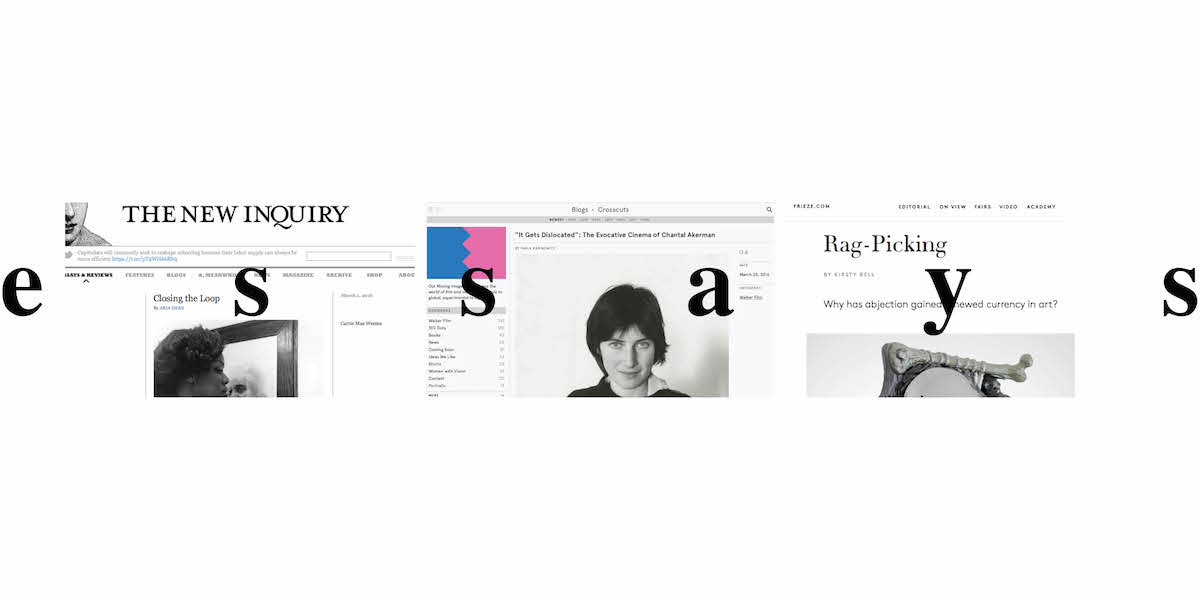
ESSAYS
Aria Dean, “Closing the Loop,” The New Inquiry.
This widely-shared essay by Aria Dean reveals the complex effects of racial, gendered, and non-binary (in)visibility and self-representation on the seemingly benign ‘selfie politic’ in art and culture more widely. By complicating what it means for marginalized individuals to take their image and visual dissemination into their own hands, Dean challenges the structures of power that have claimed the selfie to demand new modes of self-imaging that tackle the oppressing gaze in more direct terms.
“The Internet already flattens subjectivities into networks of branded associations and metadata. Mental and social operations are concretized and subjects are made objects in a platform-based social world. In this schema, it is perhaps inadvisable for those of us whose subjectivities have not yet been recognized on a large scale to objectify ourselves further using the tools vetted by those who perpetuate our oppression to begin with — even in efforts toward documenting one’s life with the hope of subverting external expectations.”
Paula Rabinowitz, “’It Gets Dislocated’: The Evocative Cinema of Chantal Akerman,” Crosscuts.
English professor Paula Rabinowitz contemplates death differently in her tribute on the late Belgian filmmaker Chantal Akerman. Where the untimely passing of artists including Francesca Woodman and Eva Hesse irrevocably altered the reception of their practices, Rabinowitz tracks questions of loss, the body, and womanhood across a career that consistently treats and evolves these themes over time. Her stirring piece refuses to shy away from the emotional gravity of Akerman’s films and seeks solace and understanding in a moment of isolation.
“Akerman’s rigorous structural apparatus of the full-frontal camera fixing walls, doors and windows or the long slow tracking shots made across landscapes and through interiors are means to design order. But they too, in their address to our physical bodies as much as our emotions, are forms of chaos. […] Stasis encloses chaos, an impossible attempt to keep it at bay.”
Kristy Bell, “Rag-Picking,” Frieze.
Kristy Bell’s essay traces the history and recent rise of artwork that incorporates debris and detritus (what she labels as ‘abject’) in this smart and demanding essay. Laden with examples and historical breadth, Bell’s piece picks up on the unique condition of refuse—between personal artifact and strewed waste—to posit the analogous potential of debris in contemporary art to substantiate and propagate the everyday.
“These remnants have an undisclosable significance beyond the symbolic order of what we know. Coloured by grief or a wan nostalgia, debris can articulate the past, or the inevitable changes washed along with time, without recourse to the sentimental.”
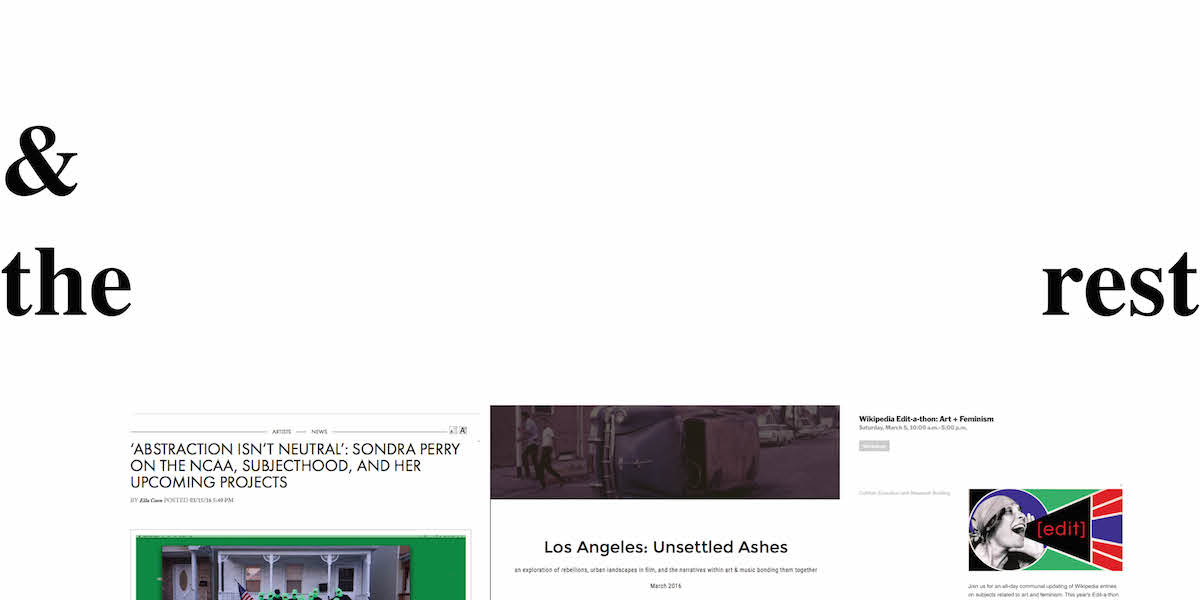
& THE REST
Sondra Perry and Ella Coon, “’Abstraction isn’t Neutral’: Sondra Perry on the NCAA, Subjecthood, and her Upcoming Projects,” ARTnews.
Sondra Perry’s multichannel video Lineage for a Multiple Monitor Workstation: Number One was a part of MoMA PS1’s “Greater New York” and presents a gripping, even hypnotizing confluence of myth, meaning, and virtual distraction. In conversation with writer Ella Coon, Perry offers the conceptual impetus behind her projects, which importantly politicize abstraction and nuance subjecthood.
“Abstraction isn’t neutral. Abstraction allows you to turn an entire group of people into a monolith. And when political abstractions happen over marginalized bodies, that’s a huge issue. But at the same time, there’s a tremendous amount of power you can give or gain through this, the use of this concept. That idea is core to my work, the questions of, What does abstraction do, and how can I use it responsibly?”
“Los Angeles: Unsettled Ashes,” BLVCK VRCHIVES.
This month, BLVCK VRCHIVES released a featured archive that weaves a narrative of 20th century Los Angeles through moments of activism, social rebellion, and marked achievement. This visual history is guided by excerpts from then-contemporary journalism and instances of film, music, and art—including work by Noah Purifoy, Dana Lixenberg, and Kerry James Marshall—that help to characterize and elucidate the city’s vibrancy and spirit over the decades.
“In these paintings of public housing life, there are no abandoned cars, litter, rubble, ripped-out playgrounds or forlorn window frames. There are bluebirds, tailored bushes, well-kept trees. But there is a mystery to them, as if each painting portrays a haunted or enchanted castle and things are not as they seem. There is more—hidden somewhere. About to be unlocked.” (Excerpt from “Chicago Tribune: An Artist’s Vision, Kerry James Marshall’s ‘Garden Project’ is Opening Eyes” by Anne Keegan [1995])
Orit Gat, Jenna Wortham, Reina Gossett, and Fiona Romeo, “Wikipedia Edit-a-thon: Art + Feminism,” The Museum of Modern Art.
In conjunction with their annual Wikipedia Edit-a-thon, MoMA hosted a panel featuring a handful of outstanding (and a few of my current favorite) writers and thinkers, including Jenna Wortham, Orit Gat, and Reina Gossett. The resulting conversation speaks transparently to topics of feminism and information in the post-digital age and offers keen perspectives on the ways in which structures of knowledge shape legacies and currencies of thought.
“In the past year or so, I’ve been thinking a lot about what it might mean to live according to your politics. I’m not really sure how to explain that except to say that to me to be a feminist also means to understand that all struggles are the same. […] I wonder if the Internet and if Wikipedia and if these conversations here could be a way for a very inclusive feminism that actually leads a lot of other struggles too. –Orit Gat
Author Joseph Shaikewitz is a Baltimore-based writer and curator from St. Louis, MO. He is the Gallery Manager at Hamiltonian Gallery in DC and a graduate of Johns Hopkins University.
